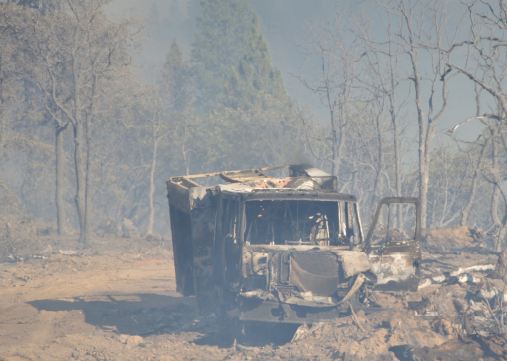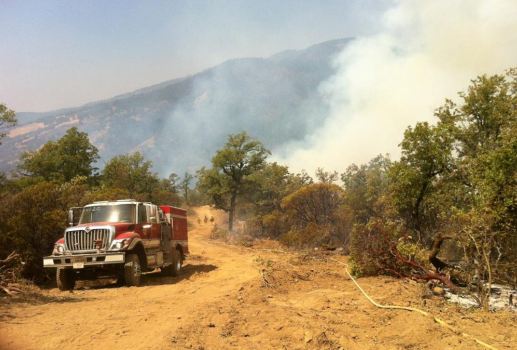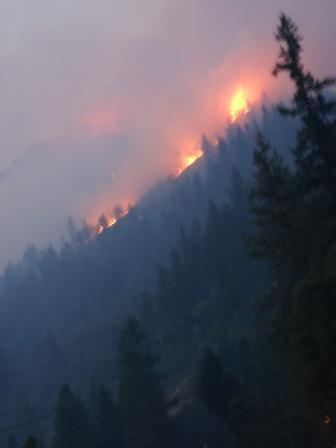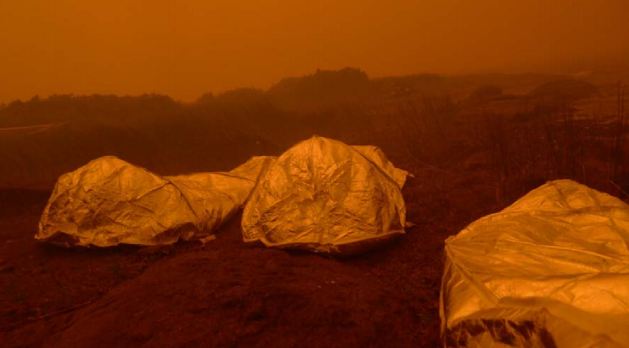
A Facilitated Learning Analysis has been released for the engine burnovers and entrapments that occurred on the North Pass Fire on the Mendocino National Forest in northern California, August 25, 2012.
You can read the entire report (large 3.8MB file), but here is a very brief summary. On August 18,2012, five Type 3 Engines from municipal fire departments in southern California were working as a Type 3 Engine Strike Team with the assignment that day of securing a dozer line. Due to dense vegetation along the dozer line, and a lack of information about their situation, they were surprised when a spot fire caused by a burning tree resulted in a fire that overran their position.

The crew from E-2 dismounted to assist with the spot fire, leaving the engine operator to button it up, disconnect hoses, and move it to assist with the spot fire at another location along the dozer line. The fire approached the engine before the operator was able to relocate the engine. He decided to run down the dozer line to escape, telling a hand crew after he reached safety, “F*** my engine burned up…. F*** my engine burned up!” Hand-crew members responded, “It’s fine, it’s fine. You’re alive so it’s fine.”
A second engine was also burned over, according to the report:
At the same time fire is engulfing E-2, E-5 finds their egress cut off by the flames now lying over the dozer line. E-5 was then forced to withdraw to a safe area. Capt. E-5 notifies ST-1C STEN they are remaining at their current location and requests permission to fire out the area around them. ST-1C STEN tells them, “Do what you need to do.” The crew of E-5 pre-treats the area around them using Class A foam, depleting their water supply. E-5 then deploys thermal curtains, and they seek shelter in the apparatus as the fire burns around them.
After the burnovers the strike team was sent to a USFS work station. The Strike Team Leader reported to a Ground Support Unit Leader who escorted them to the Incident Base. After receiving medical evaluations, all personnel were cleared by the Medical Unit and received no injuries.
Below are excerpts from the lessons learned, as shared by the facilitated learning analysis participants:
- “Try to think more three-dimensionally. I really didn’t see/perceive the layout of the road, the green, or the fire. It would of helped to realize the danger there.”
- “Maybe a picture from the air.”
- ”I wish I’d known I had a qualified faller. Don’t know that I would of used them.” [to cut down the tree throwing out burning embers that caused the spot fire.]
- “Had I perceived the danger, I wish I’d thought twice about the assignment for E-2.”
- “I will definitely request more 800 MHz radios.”
- From the Division Supervisor: “It would have been more appropriate to recognize that their (ST-1C) specialties were in other areas of firefighting and take the time to give them a more thorough briefing on the assignment rather than handing them off to be briefed by ST-2C STEN.”
- “Walking through it afterward, E-2 was in perfect alignment with the draw, but of course you couldn’t see with all of the vegetation.”
- From Capt. E-1: “Should of used a faller to drop the problem tree in the first place. Use the professionals.”
- And from the same Capt: “There are all these other resources that we don’t normally deal with, like fallers, inmate crews and dozers. We had resources we could have used, but I just didn’t have the experience to think to ask for them.”
Excerpts of observations from the FLA team members:
- The participants believe the division was large and complex. Geographically the division stretched over 5 to 7 miles of line.
- The participants felt complexity and scope of the division complicated communications over the assigned tactical channel. Early on in the shift it was identified that communications were difficult. To mitigate it, ST-1C began using their 800 MHz for intra-crew communications. One difficulty was that not everyone had both radios. Some had the 800 MHz, and some had a VHF radio, but not everyone had both. Every member should have the same type of communication capability.
- FLA team members and participants acknowledged that utilizing an unassigned tactical frequency on an incident is against several policies & guidelines.






